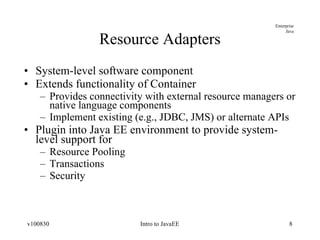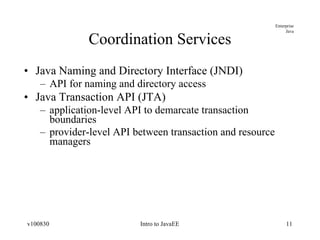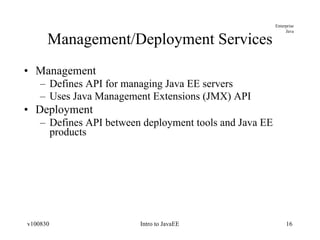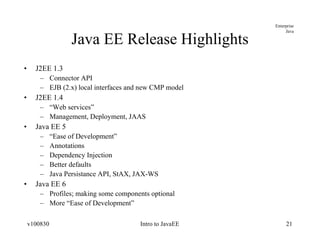Javaee intro
- 1. Java EE 5 TM Introduction
- 2. Goals Become familiar with the Java EE Architecture Understand the purpose of Java SE, Java ME, and Java EE Understand the purpose of each Java EE Container Understand the purpose of each Java EE API Understand the difference between an API and Provider Understand there are significant variations in Java EE architectures
- 3. Java Technology Levels Java Platform, Standard Edition Java SE (J2SE) core language Java Platform, Micro Edition Java ME (J2ME) targeted at small devices PDAs cell phones Java Platform, Enterprise Edition Java EE (J2EE) targeted at enterprise deployments persistence distributed systems web-based applications transactions security Note: Java Technology has gone through a recent name change. J2SE 5.0 stayed J2SE 5.0 J2SE 6.0 is called Java SE 6 J2EE 5.0 became Java EE 5 J2ME will become Java ME
- 5. Java EE Architecture Does not imply physical partitioning into machines, processes, etc. No “all or nothing” requirement use what you need
- 6. Containers Provide Java EE runtime environments with J2SE v5.0 Provide required services to application components example services: JMS, JTA application components: Applets, Java applications, Servlets/JSPs, and EJBs Understand application component deployment formats Interposes between application components to transparently inject services required transactions, security checks, resource pooling Synonymous with application server from the application developer point of view
- 7. Application Components Application Client Java programs that execute outside of the EJB, Web, and Applet Containers Typically GUI-based Applets GUI components typically execute in Web browser Web Applications accessed through HTTP primarily generate HTML and XML output Servlets, JSPs, JSF, etc. Enterprise Java Beans (EJB) execute in managed environment that include transactions typically provide business logic for Java EE application
- 8. Resource Adapters System-level software component Extends functionality of Container Provides connectivity with external resource managers or native language components Implement existing (e.g., JDBC, JMS) or alternate APIs Plugin into Java EE environment to provide system-level support for Resource Pooling Transactions Security
- 9. Standard Services Communications Services HTTP J2SE java.net package defines client-side API Java EE defines server-side API defined within servlet, JSP, JSF, and Web service interfaces HTTPS use of HTTP over SSL for transport level security Java Message Service (JMS) API for messaging support for publish-subscribe and point-to-point
- 10. CORBA Support Services RMI-IIOP APIs (javax.rmi) to allow RMI-style programming independent of underlying protocol J2SE native RMI Protocol (JRMP) CORBA IIOP protocol Permit Java EE application components to access CORBA services compatible with RMI programming restrictions Permit CORBA clients to access EJB components Using dependency injection versus JNDI lookup eliminates the need for applications to use most of API Java IDL Permit Java EE application components to invoke CORBA services, independent of the RMI API
- 11. Coordination Services Java Naming and Directory Interface (JNDI) API for naming and directory access Java Transaction API (JTA) application-level API to demarcate transaction boundaries provider-level API between transaction and resource managers
- 12. Persistence Services Java Database Connectivity (JDBC) API API for connectivity with relational databases Java Persistence API API for managing persistence and object/relational mapping Required in Java EE Can be used in J2SE environments (is part of Java SE 6)
- 13. XML and Web Service Services Java API for XML Processing (JAXP) integrated API support for separate SAX, DOM, and StAX (Streaming API for XML) XML parsing APIs XSLT transform engines Java API for XML-based RPC (JAX-RPC) legacy API for Web services Java API for XML Web Services (JAX-WS) follow-on to JAX-RPC primary API for Web services includes SOAP and RESTful Web service bindings uses Java Architecture for XML Binding (JAXB) to define Java to XML bindings uses SOAP w/ Attachments API for Java (SAAJ) to manipulate low level SOAP msgs Web Services Metadata defines Java language annotations for developing Web services Java API for XML Registries (JAXR) API for client access to XML registry servers
- 14. Security Services Java Authentication and Authorization Service (JAAS) enables services to authenticate and enforce access controls Java implementation of standard Plugable Authentication Module (PAM) Java Authorization Service Provider Contract for Containers (JACC) defines contract between Java EE application server and authorization service provider
- 15. System Services Java EE Connector Architecture (was J2CA) provider-level interface for Resource Adapters to integrate Enterprise Information Systems into Java EE servers. connection management resource pooling transaction management integrate transactions across multiple resource managers import transaction contexts into server security access thread management allows resource adapter to allocate server threads for work message delivery integrate any messaging provider; not just JMS optional, generic API between application program and resource adapter
- 16. Management/Deployment Services Management Defines API for managing Java EE servers Uses Java Management Extensions (JMX) API Deployment Defines API between deployment tools and Java EE products
- 17. Other Services JavaMail API and service provider for sending e-mail notifications JavaBeans Activation Framework (JAF) API for handling MIME types
- 18. Java EE 5 APIs and Versions J2SE v5.0 JDBC, JNDI, RMI Java Persistence 1.0 Common Annotations 1.0 EJB3.0 JMS 1.1 JTA 1.1 Servlet 2.5 JSP 2.1 StAX 1.0 Web Services 1.2 Web Services Metadata 2.0 JAX-WS 2.0 JAX-RPC 1.1 SAAJ 1.3 JAXR 1.0 JSTL 1.2 JSF 1.2 JSP Debugging 1.0 Java EE Management 1.1 Java EE Deployment 1.2 JACC 1.1 Connector 1.5 JavaMail 1.4 JAF 1.1
- 19. Java EE Product Extensions Java EE products may supply implementations, in any form, for supplied Java EE APIs different QOS, sizing, scaling, performance, cost, etc. Java EE products may provide additional APIs and protocols as extensions Java EE products may not add classes to Java API packages or change any properties of an existing Java API classes. Application use of product extensions is non-portable across Java EE products
- 20. Java EE Roles Java EE Product Provider vendor (e.g., Sun, JBoss, BEA, IBM) Application Component Provider Java, HTML, etc. developer Application Assembler integrates components into an application Deployer integrates application with resources of the runtime System Administrator monitors and tunes application after deployment Tool Provider ex. Maven Cargo plugin System Component Provider ex. external JMS provider
- 21. Java EE Release Highlights J2EE 1.3 Connector API EJB (2.x) local interfaces and new CMP model J2EE 1.4 “ Web services” Management, Deployment, JAAS Java EE 5 “ Ease of Development” Annotations Dependency Injection Better defaults Java Persistance API, StAX, JAX-WS Java EE 6 Profiles; making some components optional More “Ease of Development”
- 22. Summary
- 23. References Java TM Platform, Enterprise Edition 5 (Java EE 5) Specification (http://jcp.org/en/jsr/detail?id=244)






















